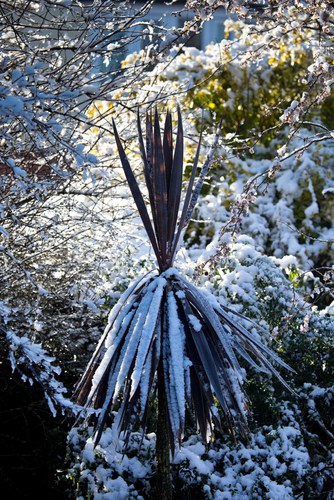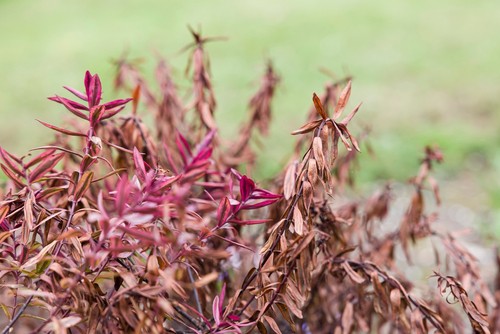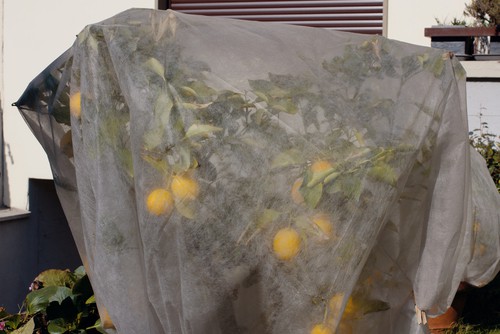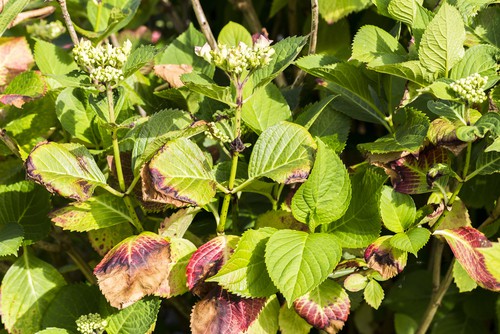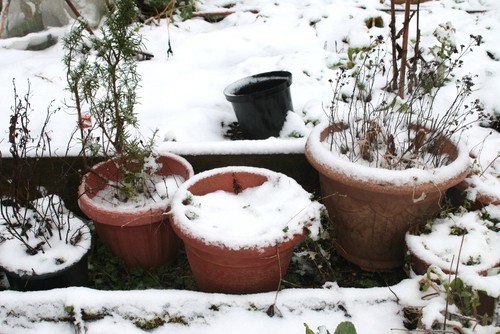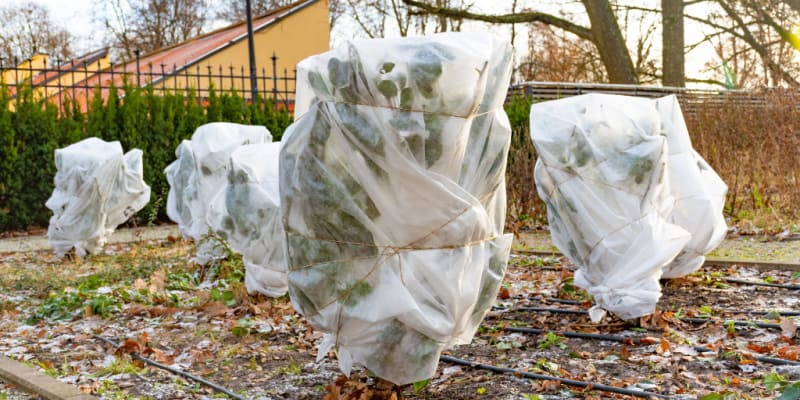
Frost damaged plants and Should you cut them back?
Our site is reader supported, this means we may earn a small commission from Amazon and other affiliates when you buy through links on our site.
Early or late-season frosts can damage plants that are normally hardy in your environment, especially if they had lots of new soft growth because this is more vulnerable to frost. The short answer to the question of whether you should cut back any frost damaged plants is ‘Not unless the risk of frost has passed’. This is statement is vital to follow if frost is still being forecasted. Don’t worry just yet though. If you have hardy plants such as shrubs, climbers, and perennials such as Lupins, they will, more than likely, come back, producing new growth once they have been cut back and recovered.
Don’t forget, if you have plants growing in pots, even hardy plants such as Hebes or a Hydrangea, they will need a little more winter protection to protect the roots (as well as any top growth) from becoming damaged, but more on this a little further down.
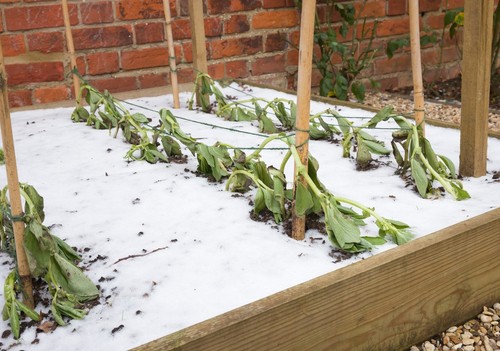
It’s also worth noting that some plants can show signs of winter damage (in the morning) with floppy wilting leaves. These include some winter vegetables like broad beans, as well as winter Pansies, Violas, and Bellis, think autumn bedding. As the sun comes up and warms the air slightly, within a few hours, they can be looking healthy again with no signs of damage at all.
With over 20 years of working in garden centres, frost damage was always a common issue both in the nursery and with customers buying tender plants such as bedding plants such as Lobelia, Marigolds, and Begonias and planting them out too early before the risk of frost has passed. Then we had the occasional year where the weather was so cold and persistent that it killed off plants that usually survive, such as conifers, shrubs, clematis, hydrangeas, and even the hardier green cordylines, even with proper winter protection given, for example, tieing up the leaves to protect the crown.
If you have frost damaged plants, usually limp or blackened foliage, then it’s best to wait until the risk of frost has passed before pruning and cleaning them up. If you prune them back too early to new healthy shoots they could be damaged by frost again, even worse than before. Any foliage that is already frost damaged will help protect the other foliage from further frost. Once the risk of frost has passed (usually May/June in most locations) I would then cut back any frost damaged foliage or stems.
How to tell if your plant is frost damaged
Not all frost damaged plants look completely dead. Here are some other tell-tale signs of frost damage. New growth may appear scorched and have brown patches between the leaf veins. Look closely at the exposed and top edges of the leaves on the plant.
Some earlier flowering shrubs, one prime example being the Pieris ‘Forest Flame’ sometimes have new foliage that turns black and flowers that turn brown. Another common victim of frost damage is shrubs that produce new foliage quite early on in the season, such as the Photinia ‘Red Robin’. They often produce bright red foliage in spring only for a late frost to turn the new foliage brown. This damage causes the leaves to shrivel up and drop off. It is never really fatal, but for a time (until new growth appears) it can look very unsightly. However, Photinias always recover well.
There isn’t any hardy evergreen plant that is completely invincible against frost, all plants can become frost damaged. Look for signs of scorching and brown discolouration on their leaves.
Autumn frosts can affect tender perennials. Their foliage becomes black and the stems usually collapse. However, this is usually a sign to cut them back for winter and maybe mulch over the crowns to protect them over winter.
On fruit trees, blossoms and young fruit may develop a cork-like layer at the flower end of the fruit after a hard spring frost. Damage to the blossoms leads to no fruits forming. This is specifically true for apricots, but it can also affect any early flowering fruit trees.
Late spring frosts also affect bedding plants. This damage usually causes leaf scorch and browning, but in severe cases, it can even kill the plants. Bedding plants are more at risk from an unexpected late frost than any other plants. Because of this, it is important if you purchase them early in the season you keep them in a frost free location until all risks of frost have passed. In the UK, this is usually around the end of May.
Repeated frosts can cause spotting on the leaves of shrubs. Autumn frost damage is often an indication that winter is on its way and gives you the chance to cut back plants and tidy up your garden ready for the winter months ahead.
It’s usually the late spring frost that is a problem. Frost damage usually occurs when we have several weeks of mild weather and everything starts growing well in the garden, plants shoot and produce new soft foliage, and you feel summer is just around the corner and so do the plants. Then all of a sudden, we get a hard frost and it knocks everything back. This is the frost we really need to worry about or a prolonged hard frost in winter that can damage even the hardest of plants.
Cutting back frost damaged plants
First of all, give your plant a chance to recover, even if it looks totally dead. You would be amazed how many times someone was adamant their plant was definitely dead and I have told them to give it a few weeks or even a couple of months, and to their surprise, it shoots again, looking even better than before. Plants are resilient and recovery may take time. Some plants rejuvenate from dormant buds, with some also reshooting from just below the soil level. So don’t give up on the entire plant straight away. Some shrubs (with Fuschias coming to the forefront of my mind) can shoot again quite late in the season if they have been burnt by frost.
Damage from spring frosts
Wait until no more frost is expected, usually the end of May for most gardeners in the UK. Prune out any damaged growth, cutting it back to an undamaged side shoot or bud. Make sure you only prune the damaged parts of the plant. Don’t jump in and do a regular pruning job, your plant won’t be strong enough to handle that unless they need pruning in spring like roses. Prune to remove damaged growth to a new pair of healthy buds.
Wait to feed your plant until you see new growth and then feed in spring to give them the best start.
After a spring frost, your plant may not show signs of recovery until summer. If nothing new has appeared by mid-summer, then consider the plant a lost cause and dispose of it.
Damage from autumn frosts
As previously mentioned, frosts in mid or late autumn signal the coming of the cold winter months. You don’t need to cut back your frost damaged plant now. Leaving everything in place – even the dead bits – provides warmth and cover for any new growth in the spring.
Once spring arrives, you can remove the dead and damaged parts of the plant carefully. Be sure to be alert to any new growth and not cut into that. You can tell the healthy part if you scrape the stem and check for green tissue underneath. If you find mushy, smelly, or slimy tissues, that’s damaged plant material and you should remove it. The longer you wait to remove the frost-bitten parts of the plant, the easier it is to see what parts are productive and growing.
Here are a few ways to protect vulnerable plants from cold winters
- Choose plants that are hardy for your climate.
- Place tender perennials in a warm sunny spot (e.g. a south-facing wall).
- Cover plants with horticultural fleece if frost is forecast and you feel they’re not quite as hardy as you would like.
- Mulch around the base (the root area) of plants, shrubs, and trees to preserve warmth which protects the roots and stops water from evaporating.
- Leave the summer’s growth on plants until spring as frost protection, especially in spring when new growth is developing.
Winter protection for plants grown in pots and containers
If you grow plants in containers or pots, don’t forget to place them in a more protected position, this could be against a wall or fence, into a cold greenhouse or conservatory. You can also wrap pots in bubble wrap or lagging to protect the roots (don’t wrap the plant itself in bubble wrap or lagging) You can buy fleece jackets to protect the actual plants so consider one of these for more vulnerable plants.
Be careful with watering in winter, don’t let plants dry out totally but water only when needed letting the surface of the soil become dry again between watering.
